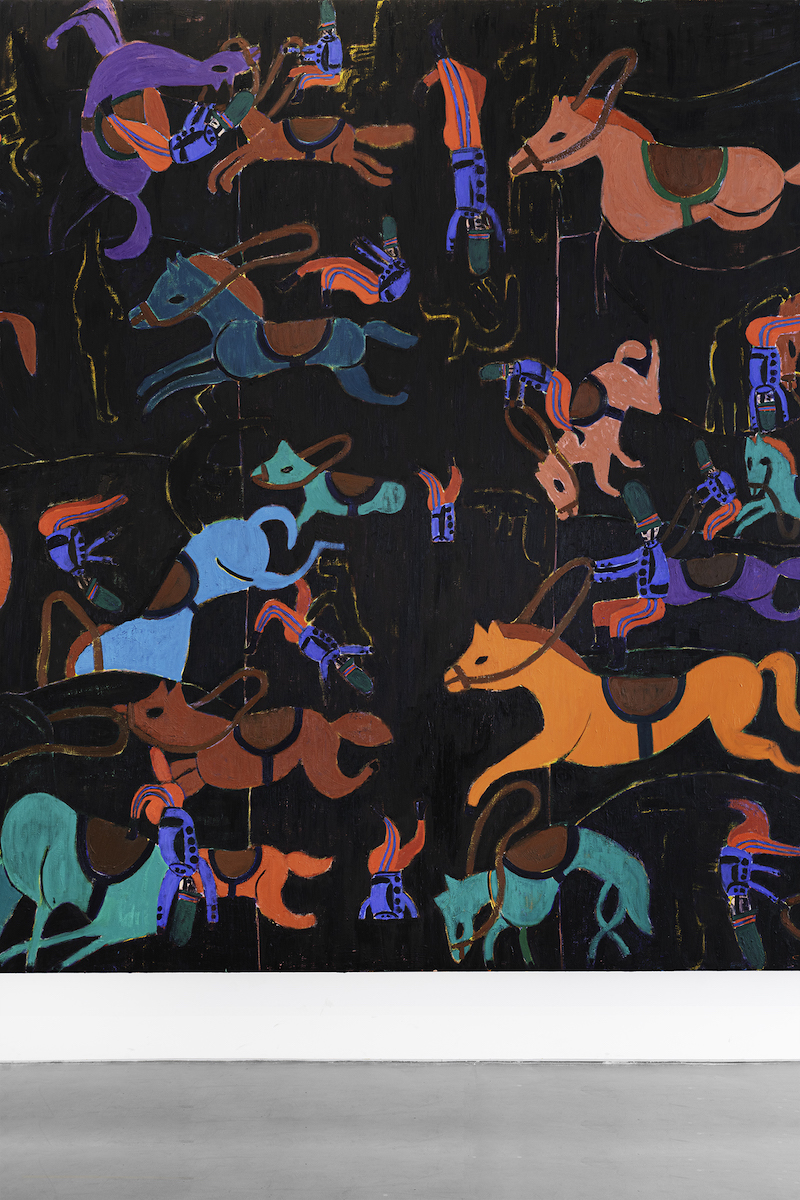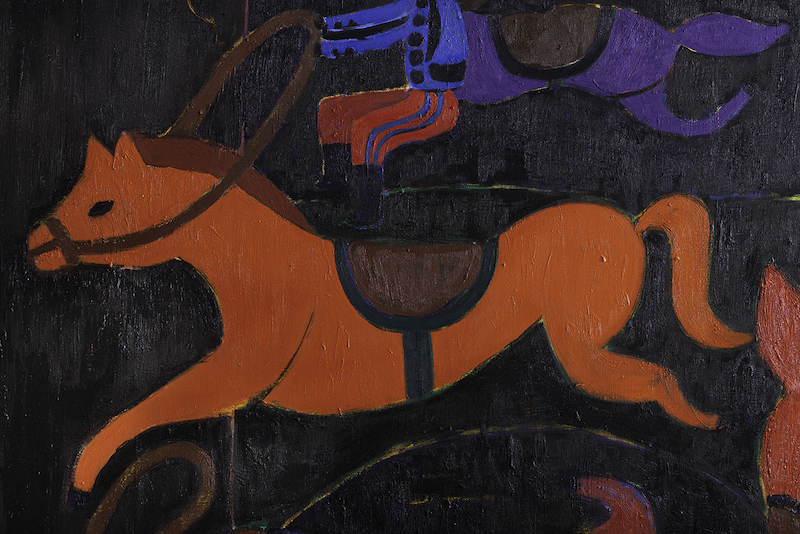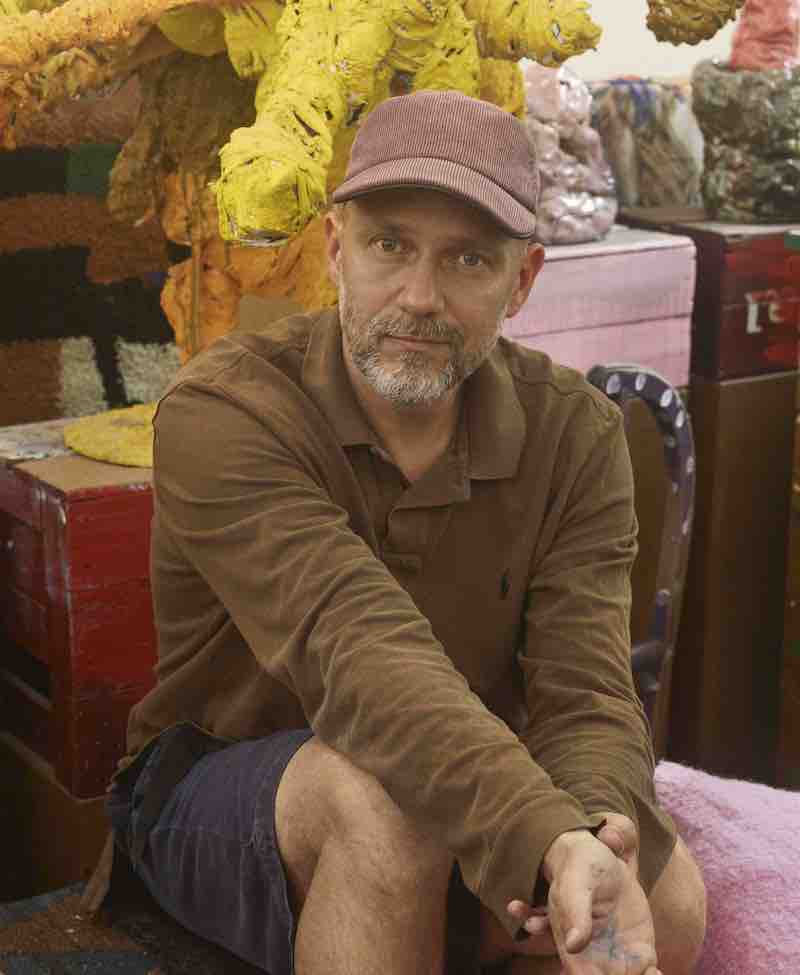
Tal R "Natten (The Night)", 2019 (Detail); ": Men Who Can't Sit on Horses" at Magasin III Jaffa, Photo: Noam Preisman
Tal R is one of Denmark's most influential artists, known particularly for his unique use of colour. Recently his show “: Men Who Can’t Sit On Horses” opened at the Museum Magasin III Jaffa in his birth city Tel Aviv. The exhibition includes only one commissioned painting, which has the exact same measurement as Pablo Picasso’s “Guernica” from 1937: 3,49 meter high and 7,77 meter wide, "Natten" (The Night) took Tal R about 9 months to finish. A conversation about bittersweet tragedies.
Anna-Lena Werner: Tal, how did you react when David Neuman, the curator of your current show “: Men Who Can’t Sit On Horses”, approached you with the idea to paint a painting in the exact same size as "Guernica" for Magasin III in Tel Aviv?
TAL R: To ask any painter something like that is just another way of saying "I'm going to kill you".
ALW: Why did you say "yes"?
TAL R: I told him that I would think about it for one day. I needed to see whether I had an immediate impulse, an idea. After a few hours I knew that I could do something with men who can't sit on horses. I played with that topic before and always wanted to return to that idea. I still find it elegant and brilliant, as it can go into different contexts and meanings. I didn't think about Picasso! If I thought about something, it was "The Dance" by Matisse. Over the years, it has become one of my favourite paintings. It is mystical and it has no end to it. So I called David Neuman and said I'd do it.
ALW: For Picasso the horse was a symbol connected to the notion of pain and victimhood. Since the horse is in the centre of the original "Guernica" painting, was it also your starting point?
TAL R: In a way it was. I wanted to follow the track of the horse. I don't know what horses meant to Picasso, I just know that I cannot ride a horse. The only time I tried to sit on a horse, it immediately threw me off. It is actually quite complicated to draw horses, especially the rear legs. They do something you cannot imagine: they bend one way and then weirdly the other way. You only notice it when you draw them. This is the only thing that the painting has in common with "Guernica" – the horse.


: Men Who Can't Sit on Horses, Tal R "Natten (The Night)", 2019 (Detail); Photo: Noam Preisman
ALW: The horses are moving through a dark night's landscape. What is this terrain, where are they?
TAL R: It is difficult to see, but there is actually a vertical river that cuts through the middle work. This work started as being very colourful – it was a pink river that the horses would jump over or drown in. I wanted to paint the painting into the night, to fall into the night. I painted it every day, week, and month a bit darker, while focusing on the horses and riders to become more colourful. All of the riders face the dilemma of crossing the river. The horses are doing quite well, but the riders are falling badly. The horses will just keep running. This comic is funny and tragic, a bittersweet fall.
ALW: The men are uniformed in something that looks like a soldier's outfit, but they also remind of clowns...
TAL R: ... I wanted them not directly to be soldiers, but somebody who dressed up for the occasion. They are riding 'Flaneurs'. They dressed up for this.
ALW: Where are all the horses and men riding? What is the destination?
TAL R: Nobody ever asked me that question before! The horses ride from right to left, just like you would read Hebrew. It doesn't seem to me like they would really leave the canvas, but if they do, they would start over on the right side. It would be like that famous movie "Groundhog Day", where you wake up every morning to the same day. There is no real escape. Maybe the fall is an escape, although it’s painful.


: Men Who Can't Sit on Horses, Tal R "Natten (The Night)", 2019 (Detail); Photo: Noam Preisman
ALW: Do the yellow waves in the background mark the landscape?
TAL R: Yes. And there is another element: You know, painting is all about counting the elements you put in. You can do internal mistakes and wrong counting. When I did this painting I realised that I missed a counting. There is the river, the landscape, horses and riders. So I added yellow shadows to the riders. Every third rider has a shadow that will also fall down, that adds to the drama. There is a beautiful quote by The Magnetic Fields saying "The flowers she sent and the flowers she said she sent." Those riders they fall and something falls from them. I don't want to call it their souls, but they implicate more consequences.
ALW: You have previously approached painting larger formats, such as in the series "Habakuk" that you did for Louisiana Museum in Denmark in 2017. Did that work prepare you well for painting an 8-meter canvas?
TAL R: "Natten" is the biggest painting I have ever painted. It's not even a painting anymore, but a two-room apartment in Berlin-Kreuzberg. When you manoeuvre around a painting that size, you need to be brutal. To be honest, to paint a really big painting is just as difficult as painting a really small painting. Everything in between is more do-able. But when you have an idea, then its just about adjusting the idea to the size. The most important thing is to have a strong impulse that means something to you, then you will handle all the rest. On the opposite, it is dreadful to walk into any size, if you have a weak impulse or idea regarding the work.
ALW: Do you always know what you put on the canvas before you begin working on it?
TAL R: Yes, I do. But not like a baking recipe. I work in a similar way as someone who will to hold a speech at somebody else's wedding. I'm not going to write it down from beginning to end to do a perfectly articulate speech that people will fall asleep to, I just need to have a very clear idea of a few things that I want to say.
ALW: Colours mean so much for your work. How and when do you decide which tones you use?
TAL R: If you have a strong impulse for the work, this impulse also has demands for colours. Whether you like it or not. When I did the "Natten" painting, half of the colours where already dictated by this strong impulse. The rest of the colours are just adjusting the other, very much a dialogue between impulse and adjustment. I have a fetish for Hermes, I wanted to have an oriental, orange horse in the painting. Just to find the mathematics behind drawing a horse was an interesting challenge.


: Men Who Can't Sit on Horses, Tal R "Natten (The Night)", 2019 (Detail); Photo: Noam Preisman
ALW: I noticed that many of your works focus on movements – railcars, feet and legs, running horses. How much does the notion of transit influence your practice?
TAL R: You are right. This painting is very much about transit. But I think there is a general misunderstanding that the artist is Mr. Clever, the one who knows everything about a painting. But if the artist is like that, like a puppet master who knows exactly what everything means, then for sure it's a going to be a stupid work. Because the best art works are done when topics and elements remain a mystery for the artist. You paint on mystery, not things that you already know. So when you mention "transit", I can agree, but in the end I am just as much an outsider from my work as you are. I think the painting is cleverer than me. I think the role of the artist is to make works that are cleverer than the artist.
ALW: Does that also mean that you can detach yourself from your work?
TAL R: Sure. If I wouldn't detach myself there is no room for a viewer.
ALW: That is a very reflected point of view...
TAL R: ...You know, artists have been painting something that is moving, like men riding on a horse, since 500 years. It's like a Heavy Metal performance. When Heavy Metal bands play live, there is a trick the musicians can use: Instead of letting a number fade out, they can stop abruptly. There is a physical reaction when something just stops – people start clapping as a reaction to the gap. Similar to that, when a horse is in the air, it immediately makes the viewer come into the painting because something is moving. It creates a dialogue. So, painting horses is also a way to get people into the painting.


: Men Who Can't Sit on Horses, Tal R "Natten (The Night)", 2019 (Detail); Photo: Noam Preisman
ALW: You have been born in Tel Aviv but grew up in Denmark, where you still live. Do you have a relationship to the city today?
TAL R: Oh yes. I go every year and have lots of family there. It is my second home. However, I still don't speak proper Hebrew. I am still a bit of an outsider. My name "Tal" is a typical Hebrew name, but in Denmark "Tal" doesn't mean anything. Name-wise I fit better to Tel Aviv, while look-wise I fit better to Copenhagen, where I live now. This is the valley – and Tal means valley in German – that my parents put me into. I am in-between in these two countries.
ALW: This brings us back to the riders crossing the pink river in the valley of your "Natten" painting, doesn't it?
TAL R: It does. Life has not one drama. Every day has a little drama. There is a certain point a person crosses in their life, maybe a basic thing. You will need to do this. You cannot just go from right to left, there has to be something in the middle that creates a question for the rider. Will he and how will he pass it? When they fall, maybe some will survive it. What is afterwards? That's why this painting, as you said, is about movement. And you know there is a consequence of this movement. You are in the middle of this drama.
: Men Who Can’t Sit On Horses
Magasin III Jaffa
Museum & Foundation for Contemporary Art
Tel Aviv
www.magasin3.com
www.magasin3.com
24.10.2019 - 27.03.2020

Portrait of Tal R; Photo by Casper Sejersen copyright- Paradis Tal R
Tal R held a professorship at the Kunstakademie in Düsseldorf from 2005-14 and had solo exhibitions in institutions such as the Louisiana Museum of Modern Art in Humblebaek, ARoS Museum in Aarhus, the Museum Brasileiro da Escultura in São Paulo and the Kunsthalle Düsseldorf. In 2020 his sculptures will be presented at the Glyptothek in Copenhagen.
